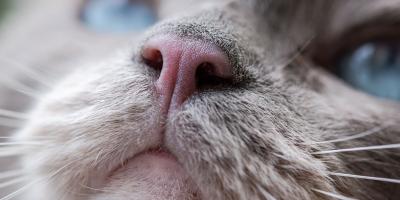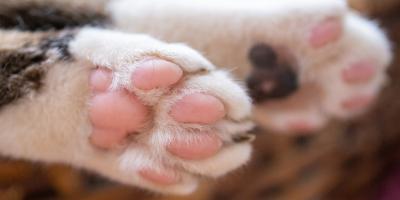Common Cat Skin Conditions & Problems


Your cat’s skin condition is a good general indicator of his or her health. The skin should be soft and supple, and the skin color will depend on the color of your cat’s fur. White, ginger, and brown cats will have pink skin, while grey and black cats will have grey skin. Calicos might have patches of both pink and grey skin.
Any changes in skin texture or coloration should be checked out by your vet.
Signs of Skin Conditions in Cats
As you pet or groom your cat, keep a look out for any changes that indicate unhealthy skin conditions in cats, such as:
- Crusts
- Scales or flaky cat skin
- Scabs
- Discharges
- White or black spots
- Dull coat
- Excessive shedding
- Bald spots
Just like us, a cat’s skin can dry out during the winter due to dry heat. Unless your cat is continually itching from dry skin, it’s normally not a serious health issue for cats. To keep your cat’s skin soft and supple, consider switching your cat’s food to a variety that supports sensitive skin. A humidifier can also keep both pets and people comfortable when the heat is turned on.
Keep an eye on your cat’s ears. Any brownish discharge or redness should be investigated by your vet. Any cat skin conditions with scabs, blackheads or white spots around the ears, mouth, or chin may be feline acne and require treatment.
Learn the warning signs so you can help your cat get the treatment he or she needs as soon as you spot something that doesn’t seem quite right.
Common Skin Conditions in Cats
There are a variety of causes for itchy, flaky cat skin conditions, from parasites to underlying diseases. That’s why it’s crucial that you visit your vet at the first sign of your cat’s skin trouble. The following are a few of the most common skin conditions in cats.
Fleas, Ticks & Mites
The most common cat skin problems are infestations of fleas, ticks, and mites. They can make your cat itch, cause inflammation and skin lesions, and if unchecked, can even lead to hair loss. In kittens and young cats, a heavy flea infestation can cause anemia, which can be dangerous to their health. Some cats develop allergies to flea saliva. The good news is most cat skin conditions involving parasites can be resolved quickly with proper treatment.
Feline Skin Allergies
Just like us, cats can develop an allergic reaction to all sorts of things that are inhaled, eaten, or touched. This reaction, which triggers inflammation, itchiness, and other feline skin conditions, is caused by antibodies that are produced by your cat’s immune system in response to an allergen.
Common cat allergens include:
- Mold, pollen, and house dust
- Fleas, flea saliva
- Certain types of food, mostly proteins
- Irritating substances your cat encounters like soaps, perfumes, household cleaner, garden sprays, chemicals, feathers, wool and even some flea collars
Ringworm and Fungal Infections
Highly contagious among cats, ringworm is a fungal cat skin condition that can spread to humans. Your vet may take a fungal culture and conduct other tests to determine if it’s ringworm. If the tests are positive, your vet may prescribe antifungal treatments.
Hair Loss (Alopecia) in Cats
Although cats shed all year long, they tend to shed more in the spring and fall. If you notice your cat losing more of their coat than normal or see bald patches, that can be a sign of alopecia.
Cat hair loss, known as alopecia, is often a result of your cat overgrooming an itchy or sore area, perhaps due to fleas, other parasites, or ringworm. Your cat may overgroom to soothe pain, for example at a joint or on the paw. Stress, due to a change in the household, moving, or the introduction of a new pet, can also cause your cat to overgroom.
Cat Rashes
Your cat may experience a rash when his or her skin comes in contact with irritants and allergens. Known as contact dermatitis, the skin becomes inflamed, reddened, and irritated. Skin rashes can also happen with certain medications and after insect bites or stings.
Cat Acne
Cat acne forms when the hair follicles are blocked by an excess production of keratin. The acne shows up as blackheads, whiteheads, and pimples around the chin and mouth of the cat. Do not try to pick or pop the acne as that can make the condition worse.
Skin Cancer
The first sign of cat skin cancer may appear as a skin lump or bump, discoloration, or even a nonhealing wound in certain areas. There are several different types and causes of skin cancer in cats. Although these changes may be benign, it’s important to see a vet when you notice a concerning change on your cat’s skin.
Diagnosing & Treating Common Cat Skin Conditions
Your vet needs to identify the cause of the rash or potential cat skin condition before recommending a treatment. Fleas and other parasites are one of the most common causes of itchiness and hair loss, so your vet might recommend a flea and tick treatment.
To diagnose ringworm, your vet may take samples of your cat’s fur or scrape a little sample of skin. This is painless for your cat. If your vet wants to do an allergy test, a larger skin sample or a biopsy, your cat will be under anesthetic for procedure. In addition, your vet may take a blood sample to check for any cat skin diseases.
If it’s a simple case of cat acne, your vet may recommend that you switch to glass or stainless-steel bowls for your cat’s food. This can help cut down on the bacteria that leads to skin acne.
For a skin cancer diagnosis, your vet may take a scraping or a biopsy of the bump to determine if it is benign or malignant. Surgery is usually the treatment of choice for most malignant tumors, depending on the type and location.
Your vet may refer you to a veterinary dermatologist if the cause of your cat’s skin issue cannot be identified or your cat does not respond to treatment.
How to Keep Cat Skin Healthy
Because cats have sensitive ears and noses, they can be prone to sunburn in the summer. Cats with white fur, cats with thin coats, and hairless cats are particularly at risk for sunburn. Protect your cats by limiting outdoor time when the sun is at its hottest.
In many cases, poor health and inadequate nutrition often cause cat skin complaints. A food rich in omega-6 fatty acids can help with your cat’s skin and coat. Building a strong immune system in your cat with proper nutrition will help defend against your cat’s skin ailments.
By following these tips and knowing how to keep your pet’s skin in tip top condition, you should have a very happy cat that you can cuddle with no worries.
Want more cat health tips? Get advice from our experts with our other cat health articles.
Related articles

Earn myPurina Rewards with Every Purchase
Use your points for treats, toys, and gift cards with myPurina app.






